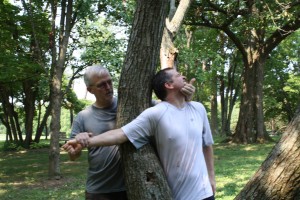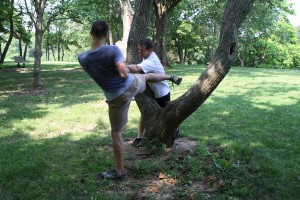My daughter graduated high school a couple of weeks back. After the ceremonies were over, a large contingent of well-wishers headed over to the local Ruby Tuesdays for a celebratory dinner.
I had the pleasure of sitting next to a couple that we don’t get to see that often. Conversation drifted back and forth over a number of different subjects when the lady of the pair mentioned a self-defense class in which she had recently participated. Well, of course that got us into some real detail as to what was taught, what I thought could have been improved upon, etc. I also mentioned that such classes tend to not really accomplish much, as neither the mind nor the body have adequate time to internalize the techniques and that having to consciously remember how to execute a technique from a class attended at some distant point in the past requires time that just doesn’t exist in a combat situation.
The husband, probably feeling a little displaced at this point, chirped “well, that’s all good, but my Sig would beat your karate.” My response was the same as every other time this asinine comment is made to me……
“Maybe. But where is your Sig at this moment?” His sheepish shrug indicated that it was safe and warm in a nightstand at home 60 miles away.
This is indicative of what I refer to as the “Second Amendment Superheroes” that seem to be popping out of the woodwork lately. They attend the necessary number of classes, pump the requisite number of rounds into stationary paper targets, get their piece of paper and now assume they are fully equipped to save the world from all sorts of evildoers. Precious few ever get beyond that point. There is no additional training and many will never again visit a range. They do not understand that, in order for their weapon to be of use, it has to actually be present when needed. There has to be adequate time and distance to draw the weapon, lock, load, aim and fire. This assumes that the intended target for some strange reason exposes himself in some way as to demonstrate that they are a threat rather than take the more common and expedient route of attacking from ambush.
In addition, the defender is no longer dealing with the aforementioned stationary paper target. The target is now moving, probably closing distance rapidly. He is probably making his intentions known in a very loud and threatening manner.
Oh……… and he probably has a weapon of his own.
Then there’s the point that I consider the most critical: The defender has to look into the eyes of another human being and pull the trigger. For all the swagger and attitude our hero might carry around with his weapon, this one point is the most important in determining the outcome of the situation. And too many will fail simply because they will not be able to allow themself to fire that round, or they will hesitate just long enough for the issue to become moot. The other side of this coin is that they will indeed fire…… over and over and over…… somewhere in the general direction of the attacker, but not with anything closely resembling controlled technique. They are now not only failing to effect a proper defense, but have instead become a danger to anyone else in the vicinity.
To use a firearm effectively for defense, there’s a whole lot more involved than going to those first few sessions. They are the very first step, not the completion of the journey. I would strongly favor the addition of combat firearm training as a prerequisite to being able to carry in public. I know dozens of people running around with a handgun in their belt or under the car seat. I can think of only a minute number of them that I feel comfortable around because I know they not only can handle their weapon, but they can also handle themselves in the bedlam that is an actual fight. That is no faint praise I give these people. The rest are running around with a false sense of security that is a serious and potentially fatal liability.
OK, so now that I’ve gone through all this, just what in the world does any of it have to do with karate??
Well, we can just as guilty of having a large, economy-sized overconfidence in our abilities. Too many of us are only half-training. All too often, I catch myself doing it as well.
See, we have an extraordinary martial arts system with masters and instructors that stack up against any other in the world. We have a curriculum of karate and ju jitsu techniques designed for effective self-defense. There’s noting wasted. There’s no fluff. We have the total package available to us.
So what’s the weak link?
It’s staring at us in the mirror.
We go to the dojo, bow in , warm up, practice kihon and kata. We do ippon and sanbon kumite. We practice blocks, throws, takedowns, kicks, single and multiple attacker situations. We do thousands of repetitions of even the most rudimentary of techniques in order to achieve the body memory needed to execute them without having to resort to conscious thought. We sweat. We sometimes bleed.
But we also do all of this in a room full of like-minded individuals, fellow students and friends. We bow to each other before practicing our assigned technique, signifying our mutual respect and understanding that we will place our partner’s safety as our first consideration. We won’t be intentionally trying to maim the person across from us. We back off a wrist lock when they tap. We control our punches and kicks. We pull up short of vital areas. We have to. To quote a line Shihan Arel used at the very first National Seminar I attended, “we all have to go to work tomorrow.”
The downside of this is that we tend to take all of the above for granted. We sometimes go through the motions of practicing while at the same time discussing what the cat did last evening or the new movie we just saw. We have become distracted (read: a target on the street). Our partner has become that stationary paper target. If we’re not careful, we’re every bit as much of a danger to ourselves as the barely-trained guy with his Sig. What should be our weapon has instead become a liability.
Wow…… so everything we’ve been doing is worthless? Not in the least. What we need to keep in the mix, though, is enough mental “realism” to our practice to get ourselves into a state of mind that will most closely simulate the real thing. This comes a whole lot easier to some of us than it does to others. Some of us have been in fights, brawls, been bouncers, have jobs as police and/or other situational backgrounds that allow us to understand that the difference between the dojo and the street can be huge. The other guy isn’t going to back off when we pat. The upside is that we don’t have to, either.
Jiyu Kumite (translation = “free sparring”) is an excellent tool for developing our combat mindset. In our class, we designate an attacker and defender. After that all bets are off. Any kind of attack is fair game. We start slow, building speed and power as the experience of the participants increase. If things start getting sloppy, we dial it back. As the student progresses, we add multiple attackers. Weapons will come into play. Other distractions are thrown into the mix. When time permits, we go from the dojo and gi to the outdoors and street clothes. We work on taking advantage of natural weapons at hand and how to move on uneven terrain. Overall, if it can happen in the “real” world, we want to get it into the training one way or another.

We have to be able to “pull the trigger” once the battle is joined. Our mental and spiritual training is every bit as important as the physical. Learning how to get ourselves into and out of a combat mindset requires just as much, if not more effort and should be part of every practice session in which we participate.
So next time you bow to your partner, treat them as such, but visualize them as the evildoer that’s trying to take your head off. It may make all the difference in a real situation.
